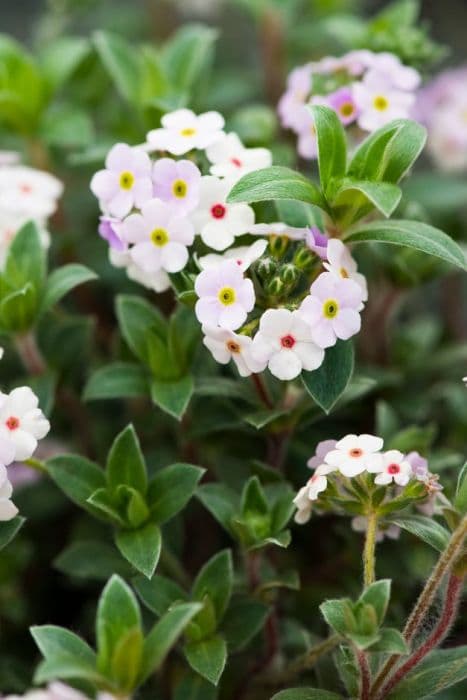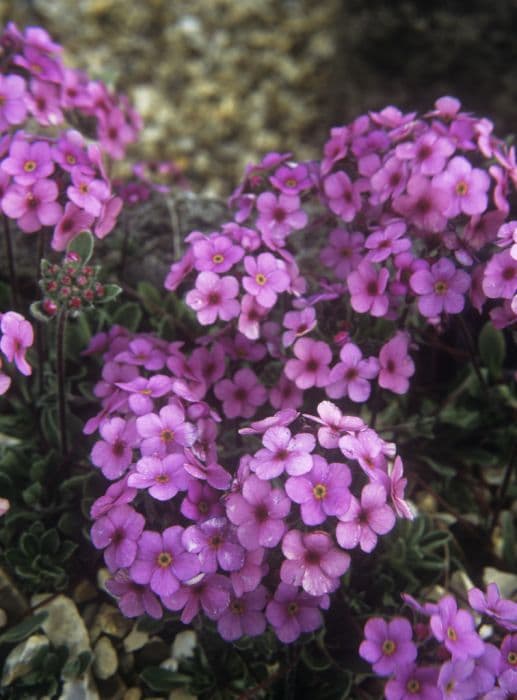Eastern Cyclamen Cyclamen intaminatum

ABOUT
Cyclamen intaminatum, commonly referred to as Cyclamen, has a distinctive and charming appearance characterized by its heart-shaped, patterned leaves and dainty, downward-swept flowers. The leaves display a variety of green hues, often with a decorative silvery or pale green marbling pattern that adds to its ornamental appeal. It is the flowers of the Cyclamen that are most captivating, with their unique reflexed petals that turn upwards, giving them an inverted appearance. The petals can range in color from white to shades of pink, often featuring a deeper-colored zone at the base, which contrasts beautifully against the foliage. The plants carry these blooms above the foliage on slender stems, adding to their delicate beauty. This combination of intricate leaves and elegant flowers creates a delightful display that is highly attractive in gardens or as potted specimens.
About this plant
 Names
NamesFamily
Primulaceae
Synonyms
Intimate Cyclamen, Miniature Cyclamen
Common names
Cyclamen intaminatum.
 Toxicity
ToxicityTo humans
Cyclamen, specifically Cyclamen intaminatum, contains compounds that may be toxic when ingested. Saponins, which are found throughout the plant but especially concentrated in the tubers (roots), can cause poisoning. If a person ingests part of a cyclamen plant, they may experience symptoms like abdominal pain, diarrhea, and vomiting. In some cases, the ingestion can lead to more severe symptoms, such as heart rhythm abnormalities or seizures, although this is rare and typically associated with ingesting large quantities. It is advisable for humans to avoid consuming any part of the cyclamen plant.
To pets
Cyclamen, including Cyclamen intaminatum, is toxic to pets if ingested, with the highest concentration of toxic saponins located in the tubers. When pets, such as cats and dogs, eat parts of the cyclamen, symptoms can include drooling, vomiting, and diarrhea. In severe cases, ingestion can cause heart rhythm disturbances, seizures, and even death, particularly if a large amount of the tuber is consumed. Pet owners should keep cyclamen plants out of reach of their animals to prevent accidental ingestion.
 Characteristics
CharacteristicsLife cycle
Perennials
Foliage type
Deciduous
Color of leaves
Green
Flower color
Pink
Height
3-6 inches (8-15 cm)
Spread
3-6 inches (8-15 cm)
Plant type
Bulb
Hardiness zones
7
Native area
Turkey
Benefits
 General Benefits
General Benefits- Ornamental Appeal: Cyclamen intaminatum features attractive and delicate flowers that can add aesthetic charm to gardens and homes.
- Compact Growth: This species often has a compact size, making it suitable for small pots and spaces.
- Seasonal Interest: Cyclamen intaminatum typically blooms in the autumn, providing color and interest during a time when other plants may be fading.
- Drought Tolerance: Once established, it is relatively drought-tolerant, making it suitable for xeriscaping and low-water gardens.
- Shade Tolerant: It can grow in shaded areas where other flowering plants might struggle, thus offering flexibility in garden designing.
- Pollinator Support: The flowers can attract and support pollinating insects, which are important for the overall ecosystem.
- Easy to Propagate: Cyclamen intaminatum can be propagated fairly easily from seed, allowing gardeners to cultivate multiple plants without the need for purchasing new ones.
 Medical Properties
Medical PropertiesThis plant is not used for medical purposes.
 Air-purifying Qualities
Air-purifying QualitiesThis plant is not specifically known for air purifying qualities.
 Other Uses
Other Uses- Cyclamen are often used as a parental plant in horticulture to create hybrids and cultivate new varieties with specific desired traits, such as color variations and resilience.
- The tubers of Cyclamen are sometimes utilized in traditional perfumery in some Mediterranean cultures due to their earthy fragrance when processed correctly.
- In small, controlled quantities, Cyclamen tubers have been historically used as a soap substitute due to their saponin content, which can produce a lather in water.
- With their unique shape and aesthetic appeal, Cyclamen flowers are sometimes dried and included in potpourri mixes to add visual interest.
- Cyclamen leaves, because of their attractive patterns, can be pressed and used in craft activities such as creating botanical prints or bookmarks.
- The flowers of Cyclamen are employed as edible decorations on cakes and pastries in upscale culinary presentations, after ensuring they are free of pesticides.
- Enthusiasts of miniature plant and fairy gardens use Cyclamen due to their small size and vibrant flowers to create enchanting garden scenes.
- Cyclamen plants, when kept in a bedroom, have been anecdotally credited with promoting a calm environment that could enhance quality of sleep.
- In some cultures, Cyclamen plants are given as gifts to symbolize sincere feelings and deep love because of their heart-shaped leaves and long-lasting blooms.
- Some artists use the intense pigments of Cyclamen petals to derive natural dyes for textiles and artwork, embracing an eco-friendly approach to their creations.
Interesting Facts
 Feng Shui
Feng ShuiThe Cyclamen is not used in Feng Shui practice.
 Zodiac Sign Compitability
Zodiac Sign CompitabilityThe Cyclamen is not used in astrology practice.
 Plant Symbolism
Plant Symbolism- Affection: Cyclamen are often used to symbolize sincere affection and love due to their heart-shaped leaves and delicate flowers.
- Goodbye: Giving someone cyclamen flowers can imply a parting or farewell, suggesting an end to a relationship or phase in life.
- Resignation and Sadness: The downward-facing direction of the blooms can represent feelings of sadness or resignation, signifying a sense of acceptance during difficult times.
- Beauty and Art: Cyclamen's unique and aesthetically pleasing appearance has also led it to be associated with beauty and the arts, celebrating creativity and aesthetic enjoyment.
- Deep Love: The durability and ability of the cyclamen to thrive in cooler climates is sometimes seen as a metaphor for a deep and enduring love that can survive hardships.
 Water
WaterTo care for the Cyclamen intaminatum, also commonly known simply as Cyclamen, proper watering is crucial. Water the cyclamen plant when the top inch of soil feels dry to the touch, typically about once a week, although this can vary depending on environmental conditions. Apply water directly to the soil, avoiding the leaves and flowers to prevent fungal diseases. During the active growing season (fall and winter), Cyclamen prefer regular, even moisture, so make sure to provide around 8-16 ounces of water weekly. However, reduce watering after the flowering period as the plant enters dormancy, allowing the soil to dry out slightly more between waterings.
 Light
LightCyclamen thrive in bright, indirect light, away from direct sunlight which can scorch their leaves. Ideally, place your Cyclamen intaminatum in an east or north-facing window where it will receive plenty of light without the risk of direct sun exposure. If you only have a south or west-facing window, use a sheer curtain to diffuse the light.
 Temperature
TemperatureCyclamen intaminatum prefers cooler temperatures and performs best in a range between 60-70°F. It's essential to protect the plant from extremes, ensuring that temperatures remain above 40°F to prevent cold damage and below 77°F to avoid heat stress. These cool-loving plants may go dormant if exposed to temperatures outside their comfort zone, especially during the hot summer months.
 Pruning
PruningCyclamen intaminatum benefits from pruning to remove yellowing or wilting leaves and faded flowers, which encourages new growth. Prune the plants by gently pulling out the fading leaves and flower stems from the base to avoid damaging the tuber. Pruning is generally done after flowering ends and is repeated whenever necessary during the growing season to maintain the plant's appearance and health.
 Cleaning
CleaningAs needed
 Soil
SoilCyclamen intaminatum, commonly known as Miniature Cyclamen, thrives best in a soil mix comprising one part potting soil, one part perlite or pumice, and one part fine bark to ensure good drainage. A slightly acidic to neutral pH of 6.5-7.0 is ideal for this plant.
 Repotting
RepottingMiniature Cyclamen should typically be repotted every one to two years or when the tuber has consumed most of the pot space. It's important not to bury the tuber too deep during repotting to prevent rot.
 Humidity & Misting
Humidity & MistingMiniature Cyclamen prefers high humidity levels around 50-70%. To maintain these conditions, you may need to use a humidifier or place the pot on a wet pebble tray.
 Suitable locations
Suitable locationsIndoor
Place Miniature Cyclamen in bright, indirect light indoors.
Outdoor
Ensure dappled shade and shelter for Miniature Cyclamen outdoors.
Hardiness zone
5-9 USDA
 Life cycle
Life cycleCyclamen intaminatum, commonly known as the "Miniature Cyclamen," begins its life cycle as a seed, typically sown in the fall, which germinates in a cool, moist environment. After germination, it develops a tuber, from which heart-shaped leaves emerge, marking its growth into a seedling. As it matures, the plant undergoes a vegetative phase, wherein leaves grow and photosynthesize to provide energy for the next stage. The reproductive phase follows, typically signaled by the blooming of small, delicate flowers with upswept petals, ranging from white to pale pink, in late summer to autumn. After pollination, possibly by insects, the flowers develop into seed capsules, which when ripe, will open to release the seeds to the surrounding area. During harsh weather conditions, the plant enters a dormancy period, where the leaves die back, and the tuber conserves energy until favorable growth conditions return.
 Propogation
PropogationPropogation time
Spring-Early Summer
Cyclamen intaminatum, commonly known as the Eastern Cyclamen, is most effectively propagated by seed. The best time to sow seeds is in the fall, shortly after they've matureed. To propagate, seeds should be sown in a well-draining soil mix, superficially covered with soil, and kept at a steady temperature of around 60 to 68 degrees Fahrenheit (15.6 to 20 degrees Celsius). The soil should be kept moist but not waterlogged, and the seeds typically germinate in 30 to 60 days. Seedlings require careful handling and should be grown in their containers until they are strong enough to be transplanted outdoors after the risk of frost has passed.









